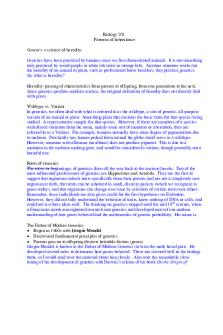Drosophila Simulation - Patterns of Heredity Laboratory PDF

| Title | Drosophila Simulation - Patterns of Heredity Laboratory |
|---|---|
| Course | Genetics |
| Institution | Batangas State University |
| Pages | 10 |
| File Size | 753 KB |
| File Type | |
| Total Downloads | 1 |
| Total Views | 155 |
Summary
Students will learn and apply the principles of Mendelian inheritance by experimentation with the fruit fly Drosophila melanogaster. Students will make hypotheses for monohybrid, dihybrid and sex-linked traits and test their hypotheses by selecting fruit flies with different visible mutations, matin...
Description
L
aboratory Experiment (Virtual Simulation)
Drosophila Simulation - Patterns of Heredity BLOCK: BS BIOLOGY 2203 Group Number: Group 2 Leader: ILAO, AMIERAH ANGELA Group Member: B
ARY
Objective: Students will learn and apply the principles of Mendelian inheritance by experimentation with the fruit fly Drosophila melanogaster. Students will make hypotheses for monohybrid, dihybrid and sex-linked traits and test their hypotheses by selecting fruit flies with different visible mutations, mating them and analyzing the phenotypic ratios of the offspring.
Website: https://www.biologycorner.com/worksheets/drosophila_simulation.html (use this link for the simulation)
The image above shows a wild-type female fly (left) and a male fly. The “wild-type" refers to the most common or typical form seen in the wild. A + sign is used to denote when a fly displays the wild-type characteristic. Procedure Open the simulation using the link provided. Examine the phenotypes available from the left side menu to answer the following questions.
A. 1. Examine the different types of bristles seen in flies. Geneticists use a shorthand labeling system, F = forked. Identify the phenotypes (observable characteristics) shown:
Singed
Shaven
2. Compare antennae types. How is "aristapedia" different from wild-type?
Aristapedia can be perceived differently from the wild-type by pointing out that its antennae stick straight out from its head. The wild type, on the other hand, possesses a hazy antennae that branches out to both sides of its head. 3. What are different eye colors in fruit flies? Circle the one that is wild-type.
Based on the virtual lab provided earlier, fruit flies may possess five (5) eye colors including; brown, purple, sepia, white, and red. The wild-type is red.
4. Regarding wing size, what is the difference between apterous and vestigial?
Apterous means having little to no wings at all, on the other hand, vestigial describes a pair of wings but is not able to fly.
5. What are the body colors in fruit flies?
Based on the virtual lab provided, there are six (6) body colors in fruit flies; red, black, ebony, sable, tan and yellow.
6. Create a mutant fly with any number of variations and mate it with a wild-type fly.
How many offspring were wild-type? _2_
* You may realize that choosing a lot of different types of flies make it difficult to analyze inheritance patterns. 7. Mate the offspring of the cross. Use the analyze tab to get more details about the F2 offspring. (The button to "ignore sex" may make counting easier.)
How many wild-type offspring were produced? __2__
How many mutant flies were produced? _2_
B. Your next tasks will focus on analyzing single traits within flies to determine how they are inherited. 1. Reset all flies in the design tab. 2. Design a male fly with vestigial wings and cross it with a wild-type female.
3. Add the results to your "Lab Notes."
4. Mate the offspring of this cross.
5. Based on these two crosses you probably have an idea about how vestigial wings are inherited. ● Is VG recessive or dominant? recessive ● How do you know? Since the VG trait was not evidently passed onto the offspring of the first cross, which justifies that it wasn’t shown on both parents. If the VG trait is not evident on the wild-type female fly and only the male fly has shown this trait, thus; it is a recessive trait. 6. In genetics, numbers are statistically analyzed. The fly simulator has a built into it. Under the Analyze tab, you can click on "Include a test hypothesis." If your hypothesis that VG is a recessive trait is correct, then you would expect what proportion of the F2 offspring to have vestigial wings? Input your hypothesis (numerical only) in the table and select the test your hypothesis. Hₒ = 0.0000≥Pᵥ...
Similar Free PDFs

Basic Principles of Heredity
- 23 Pages

2-Basic Principles of Heredity
- 23 Pages

Patterns OF Inheritance Notes
- 7 Pages

Patterns of Inheritance
- 3 Pages

Drosophila-melanogaster
- 13 Pages

SIKLUS HIDUP DROSOPHILA
- 14 Pages

Pengenalan Mutan Drosophila
- 15 Pages

Drosophila Lab Report
- 11 Pages

Mutaciones de Drosophila
- 23 Pages

Organizzatori in Drosophila
- 7 Pages

5 - Embryogenese Drosophila
- 5 Pages
Popular Institutions
- Tinajero National High School - Annex
- Politeknik Caltex Riau
- Yokohama City University
- SGT University
- University of Al-Qadisiyah
- Divine Word College of Vigan
- Techniek College Rotterdam
- Universidade de Santiago
- Universiti Teknologi MARA Cawangan Johor Kampus Pasir Gudang
- Poltekkes Kemenkes Yogyakarta
- Baguio City National High School
- Colegio san marcos
- preparatoria uno
- Centro de Bachillerato Tecnológico Industrial y de Servicios No. 107
- Dalian Maritime University
- Quang Trung Secondary School
- Colegio Tecnológico en Informática
- Corporación Regional de Educación Superior
- Grupo CEDVA
- Dar Al Uloom University
- Centro de Estudios Preuniversitarios de la Universidad Nacional de Ingeniería
- 上智大学
- Aakash International School, Nuna Majara
- San Felipe Neri Catholic School
- Kang Chiao International School - New Taipei City
- Misamis Occidental National High School
- Institución Educativa Escuela Normal Juan Ladrilleros
- Kolehiyo ng Pantukan
- Batanes State College
- Instituto Continental
- Sekolah Menengah Kejuruan Kesehatan Kaltara (Tarakan)
- Colegio de La Inmaculada Concepcion - Cebu




